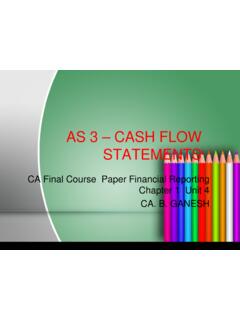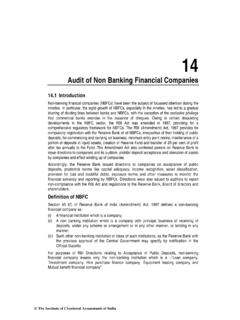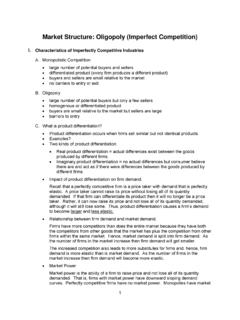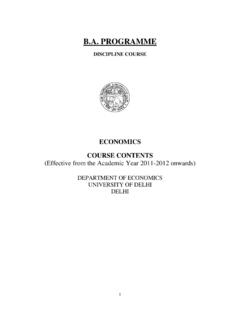Transcription of PRICE DETERMINATION IN DIFFERENT MARKETS
1 CHAPTER 4 PRICEDETERMINATIONIN DIFFERENTMARKETSUnit 3 PRICE -outputDeterminationUnder DifferentMarket Forms The Institute of Chartered Accountants of India170 COMMON PROFICIENCY TESTPRICE DETERMINATION IN DIFFERENT MARKETSL earning ObjectivesAt the end of this unit you will be able to : understand how PRICE and quantity demanded and supplied are determined in perfectcompetition, monopoly, oligopoly and monopolistic competition . understand the conditions required to make PRICE discrimination by monopolist successful. understand how firms in an oligopolist market are this unit, we shall study the DETERMINATION of PRICE and output under perfect competition ,monopoly, monopolistic competition and oligopoly .
2 Output is supplied by individual firms onthe basis of market demand and their cost and revenue functions. However, the existence ofdifferent forms of market structure leads to differences in demand and revenue functions ofthe firms. Therefore, supplies offered at DIFFERENT prices by the firm would vary significantlydepending upon the market forms. We start our analysis with perfect FeaturesSuppose you go to a vegetable market and enquire about the PRICE of potatoes from a says potatoes are for ` 5 per kg. In the same way, you enquire from many shopkeepers andyou get the same answer.
3 What do you notice? You notice the following facts :(i)There are large number of buyers and sellers in the potatoes market.(ii) All the shopkeepers are selling potatoes at ` 5.(iii) Product homogeneity all the sellers are selling almost the same quality of potatoes inthe sense that you cannot judge by seeing the potatoes from which farmer s field do theycome type of market is known as perfectly competitive market. In general, it has the followingcharacteristics :(i)There are large number of buyers and sellers who compete among themselves and theirnumber is so large that no buyer or seller is in a position to influence the demand or supplyin the market.
4 (ii) The commodity dealt in it is homogeneous, in the sense that the goods produced by differentfirms are identical in nature.(iii) Every firm is free to enter the market or to go out of the above three conditions alone are fulfilled, then it is called pure competition . Theessential feature of the pure competition is the absence of monopolistic element. The numberof producers is large, the commodity is the same and everyone has the liberty to enter theindustry. So, monopolistic combinations are not addition to the above stated three features of pure competition , some more conditionsare attached to the perfect competition .
5 They are: The Institute of Chartered Accountants of IndiaGENERAL ECONOMICS171(iv) There is a perfect knowledge on the part of buyers and sellers, of the quantities of stock ofgoods in the market, market conditions and the prices at which transactions of purchaseand sale are being entered into.(v) Facilities exist for the movement of goods from one centre to another. Also, buyers haveno preference as between DIFFERENT sellers and as between DIFFERENT units of commodityoffered for sale; also sellers are quite indifferent as to whom they sell.
6 (vi) The commodity or the goods are sold at a uniform PRICE throughout the market at anygiven point of time. In other words, all firms individually are PRICE takers, they have toaccept the PRICE determined by the market forces of total demand and total last mentioned is a consequence of the conditions prevailing in a market operating underconditions of perfect competition , for when there is perfect knowledge and perfect mobility, ifany seller tries to raise his PRICE above that charged by others, he would lose his there are few examples of perfect competition which is regarded as a myth by many.
7 Thegrain or stock MARKETS approach the condition of perfect DETERMINATION under perfect competitionEquilibrium of the Industry : An industry in economic terminology consists of a large numberof independent firms, each having a number of factories, farms or mines under its such unit in the industry produces a homogeneous product so that there is competitionamongst goods produced by DIFFERENT units called firms. When the total output of the industryis equal to the total demand, we say that the industry is in equilibrium; the PRICE then prevailingis equilibrium PRICE , whereas a firm is said to be in equilibrium when it has no incentive toexpand or contract stated above, under competitive conditions, the equilibrium PRICE for a given product isdetermined by the interaction of the forces of demand and supply for it as is shown in figure 7 : Equilibrium of a competitive industryIn Fig.
8 7, OP is the equilibrium PRICE and OQ is the equilibrium quantity which will be sold atthat PRICE . The equilibrium PRICE is the PRICE at which both demand and supply are equal andtherefore, no buyer who wanted to buy at that PRICE goes dissatisfied and none of the sellers isdissatisfied that he could not sell his goods at that PRICE . It may be noticed that if the PRICE wereto be fixed at any other level, higher or lower, demand remaining the same, there would not be The Institute of Chartered Accountants of India172 COMMON PROFICIENCY TESTPRICE DETERMINATION IN DIFFERENT MARKETSan equilibrium in the market.
9 Likewise, if the quantities of goods were greater or smaller thanthe demand, there would not be an of the Firm : The firm is said to be in equilibrium when it maximizes its profit. Theoutput which gives maximum profit to the firm is called equilibrium output. In the equilibriumstate, the firm has no incentive either to increase or decrease its output. Since it is the maximumprofit giving output which only gives no incentive to the firm to increase or decrease it, so it isin equilibrium when it gets maximum in a competitive market are PRICE -takers. This is because there are a large number offirms in the market who are producing identical or homogeneous products.
10 As such thesefirms cannot influence the PRICE in their individual capacities. They have to accept the pricefixed (through interaction of total demand and total supply) by the industry as a the following figure :PRICESSDDPQUANTITY(a) MarketPRICEPQUANTITY(b) Individual SellerD/AR/MRXYNMO Fig. 8 : The firm s demand curve under perfect competitionIndustry PRICE OP is fixed through the interaction of total demand and total supply of theindustry. Firms have to accept this PRICE as given and as such they are PRICE -takers rather thanprice-makers.












